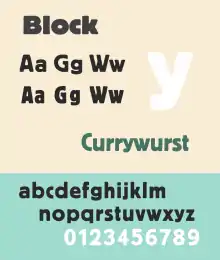Berthold Block
Berthold Block is a sans-serif typeface released by the H. Berthold foundry in the early twentieth century and intended for display use.[1] Block has a chunky design suitable for headings, with short descenders allowing tight linespacing and rounded corners.[2][3] It is sometimes simply called "Block". Font design expert Stephen Coles describes it as "a soft but substantial display face with compact dimensions and an organic appearance…[it] isn’t meant for body copy."[4] The Block design has been credited by the Klingspor Museum to Hermann Hoffmann, who managed type design for Berthold.[5][6]
 | |
| Category | Sans-serif |
|---|---|
| Designer(s) | Hermann Hoffmann |
| Foundry | H. Berthold |
| Date created | 1908 |
The original metal type release of Block was intentionally "distressed" in style, matching the effect of worn type; some rereleases have a cleaner design. Ferdinand Ulrich suggests that this was to match the organic feel of advertising lettering of the time, including the work of Lucian Bernhard.[7] Block was one of Berthold's most popular typefaces, and was released in a wide range of versions, including lighter weights and type in wood (for large sizes) and hard-wearing steel.[8] Metal type versions had stylistic alternate characters such as a more compact 'S' to allow fine-tuning of appearance of type and fit the desired number of characters into a line.[9]
History

Berthold Block was released in 1908; Berthold later added additional weights and styles, also releasing phototypesetting versions.[10][11] It was often used by Praktiker and by the Whitechapel Art Gallery for branding in the 1970s and 80s.[12][13] Berthold also used the name "Block" for a number of other typefaces not particularly closely related to it as a brand extension marketing strategy. These included the script font "Block-Signal" and the blackletter Block-Fraktur.[1]
In the late 1970s, Berthold re-released three lighter-weight fonts derived from the Block design as a mini-family named "Berliner Grotesk" for phototypesetting, with the font redraw carried out by Erik Spiekermann.[7][14][lower-alpha 1]
Digitisations

A variety of digitisations of Block exist, including by Berthold and successor companies and by Bitstream (the condensed weight only).[15][16][17] Paratype of Moscow released an expansion with Cyrillic characters in 1997.[2] Matthew Butterick's Hermes, released by Font Bureau, is a loose adaptation also inspired by other German grotesque typefaces of the period, adding lighter weights and unicase features.[18]
References
- "Block - Fonts in Use". Fonts in Use. Retrieved 12 June 2016.
- Safayev, Tagir. "Paratype Bloc". Paratype. Retrieved 12 June 2016.
- "Block Berthold". Typewolf. Retrieved 12 June 2016.
- Coles, Stephen. "In Pieces website". Fonts in Use. Retrieved 12 June 2016.
- "H. Berthold AG" (PDF). Klingspor Museum. Retrieved 12 June 2016.
- Devroye, Luc. "Hermann Hoffmann". Type Design Information. Retrieved 12 June 2016.
- Ulrich, Ferdinand. "From Condensed Light to Extended Ultra". FontShop. Retrieved 19 August 2017.
- "Block in Stahl-Typen". Flickr. Retrieved 17 December 2016.
- Coles, Stephen; Hardwig, Florian. "Berthold Block & Berliner Grotesk, 1921 Specimen". Flickr. Retrieved 17 December 2016.
- "Schriftdesigner Hermann Hoffmann" (PDF). Klingspor Museum. Retrieved 12 June 2016.
- "Berthold BQ". Berthold Types. Retrieved 12 June 2016.
- O'Connell, Steve. "Whitechapel Art Gallery". Fonts In Use. Retrieved 12 June 2016.
- Hardwig, Florian. "Praktiker". Fonts in Use. Retrieved 12 June 2016.
- "Berliner Grotesk BQ". MyFonts. Retrieved 21 August 2017.
- "Block Berthold BE". MyFonts. H. Berthold. Retrieved 12 June 2016.
- Ruecha, Stawix. "Amsi Pro (Block digitisation)". MyFonts. Stawix. Retrieved 12 June 2016.
- "Condensed Gothic 821". MyFonts. Bitstream. Retrieved 12 June 2016.
- Butterick, Matthew. "Hermes FB". Font Bureau. Retrieved 12 June 2016.
External links
- 1921 Berthold Block specimen (digitisation: Stephen Coles)